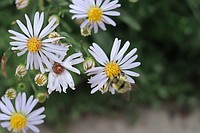The temperatures still feel like summer, but gardeners are hoping for fall — and not only because the heat should back off. With fall temperatures come fall-blooming perennials.
While many perennial plants are winding down and looking a bit sad right now, some have just begun to shine.
Choosing perennials that bloom at different times of the year is a sure-fire way to have color in every season.
MUMS
Everywhere you look you can find garden mums for sale. While they are perennials, many gardeners treat them as annuals, buying new plants each fall. Other gardeners grow them as perennials and can sometimes get two seasons of blooms out of them.
They come in a wide range of colors and flower sizes.
If you are buying plants in bloom, don't buy the ones with most of their flowers open or you won't have their full, peak color in your garden long. Choose varieties with some flowers open but with plenty of buds.
Mums do best planted in full sun to partial shade.
Photo Gallery
Fall-blooming perennials
When most of summer's cheery garden colors begin to fade away, these plants cover themselves in glory and flower on through fall.
[Gallery not displaying? Click here to view: arkansasonline.com/918plants]
GOLDENROD
Goldenrod is a wonderful late summer/fall perennial. Solidago is the genus of this member of the aster family. There are many species with lots of new varieties on the market.
This perennial plant is loaded with bright yellow blooms for months from late summer through fall. It often gets blamed for the hay fever many Arkansans suffer with in the fall, but the pollen on goldenrod is too large to float. The actual allergy-inducing weed is ragweed, which has greenish white blooms.
The main species of goldenrod we see blooming along Arkansas roadsides is the tall Solidago canadensis or Canada goldenrod. It is probably a bit too large and aggressive for most home gardens, but try some of the newer varieties such as Fireworks, Golden Cascade, Golden Fleece and Goldrush.
Not only will these plants provide you weeks of yellow blooms, they are good for bees and butterflies while in flower, and the seeds are a food source for birds in the winter.
Most species prefer full sun. They are drought tolerant and fairly pest free.
ASTERS
Asters are another great fall flower. There are many species to choose from.
These flowers are an important nectar source for insects in the late summer and fall as well as food for many butterfly larva. In the winter, small birds can eat the seeds.
Flowers come in shades of pink, purple and white.
Most asters prefer full sun and well drained soil.
SALVIA
Salvia is a must-have in the fall garden. The salvia genus is large with a very diverse mix of annuals and perennials. The perennial forms are the garden superstars.
Flower color can range from sky blue to purple, white, pink, red and even yellow. The mature size of salvia plants varies from 12 inches to 5 feet tall, depending on variety.
The red, fall-flowering pineapple sage is a winner, as is the tallest salvia — Mexican bush sage (S. leucantha), with velvety purple blooms.
While some salvias give you intermittent blooms or nonstop color in the summer, they are all ablaze in the fall garden. Not only are they showy for your garden but they are a beacon for butterflies and bees.
Salvias prefer full sun and well drained soils.
TOAD LILIES
Toad lilies are blooming their hearts out now. There are two species from which to choose — Tricyrtis hirta and T. formosana. Both produce lovely, speckled, orchid-like blooms that are very attractive to bees.
T. hirta is sometimes called hairy toad lily because all plant parts are fuzzy. It is the better behaved variety, with arching stems graced with blooms, and it does not spread rampantly by rhizomes as its cousin does.
T. formosana is taller and a bit more aggressive, with flowers borne at the top of the stems instead of cascading. Both perform well in the shade.
TURTLEHEAD
Turtlehead or Chelone is native to wet woodland areas in the southern Appalachian Mountains. Its plants will grow and bloom in light to deep shade areas with bright pink, snapdragon-like blooms. The flowers resemble the head of a turtle, thus the common name.
This plant is not drought tolerant, and it likes a well drained, but moist, rich site.
ANEMONES

Japanese anemones are another great fall bloomer for the shade garden.
Anemone varieties vary from 10 inches to 4 feet tall and are covered in single or double, white or pink blooms for weeks in the fall.
It thrives in light shade, dappled sunlight or morning sun and afternoon shade. It does best in moist, but well-drained soils. It also can spread a bit if the soil is rich.
HIBISCUS
Confederate rose (Hibiscus mutabilis) only blooms in the fall. Its showy, pink or white blooms change color over the course of a day or two, and grace a tall plant in late September through October.
While it's not reliably winter-hardy in the northern part of the state, cuttings can be taken and rooted to ensure plants return next season.
These are just a smattering of plants available for your fall garden. A great garden should have something in bloom in every season, not just spring and summer. Extending your color palette with fall-blooming perennials gives your bees and butterflies food in their lean season, plus it gives you a feast for the eyes.
Throw in some pumpkins and gourds to add to the display, and your garden will pop with color.
Janet Carson's blog is at arkansasonline.com/planitjanet.

